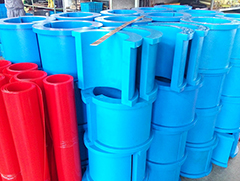Water Resistance of different urethane chapter 1
 Polyether
urethane prepolymers combine the physical properties characteristic of high
quality urethanes with excellent resistance to hydrolysis 一five to ten times that of
polyester-based urethanes. This has been demonstrated
by laboratory immersion tests and confirmed by field tests. Ester urethanes
appear to be attacked at the water sensitive ester groups, while hydrolysis of polyether
urethane canoccur only at the more hydrolytically stable urethane and urea
groups.Similar effects were observed when samples were immersed in water,
exposed to 100% relative humidity or immersed in wet oil.
Polyether
urethane prepolymers combine the physical properties characteristic of high
quality urethanes with excellent resistance to hydrolysis 一five to ten times that of
polyester-based urethanes. This has been demonstrated
by laboratory immersion tests and confirmed by field tests. Ester urethanes
appear to be attacked at the water sensitive ester groups, while hydrolysis of polyether
urethane canoccur only at the more hydrolytically stable urethane and urea
groups.Similar effects were observed when samples were immersed in water,
exposed to 100% relative humidity or immersed in wet oil.
Urethane elastomers have been widely accepted for use in demanding applications in which toughness is a prime requirement. These include solid industrial tires, rolls, and a variety of mechanical rubber items. In addition, urethanes are finding increased usage in applications that can take advantage of their fluid nature before vulcanization. These include their use in potting, encapsulating and sealing compounds, and as adhesives. Although most of the vulcanizate properties and processing characteristics of the various urethane elastomers have been described in the literature, there is very little documentation on the effect of water on these elastomers.
Because water, liquid or vapor, is nearly always present and in contact with rubber parts in service, it is important to examine its effect in detail.
Types of Urethane Elastomers Studied
Liquid urethane elastomers based both on polyalkylene ether glycols and polyester glycols were used in this study of water resistance. The polyalkylene ether glycols used were polytetramethylene ether glycol and polypropylene ether glycol.The polyesters were polyethylene adipate and mixed polyethylene propylene adipate. The prepolymers were prepared from tolylene diisocyanate (TDI), 1,5-naphthalene disocyanate (NDI), diphenylmethane diisocyanate (MDI), or m-phenylene diisocyanate (MPDI), using well known laboratory procedures. The polymers based on TDI were cured either with MOCA curing agent or with polyols, such as 1,4-butanediol or trimethylol propane. Polymers based onMDI,NDI or MPDI are much more reactive than TDI-based polymers and yield compounds with very short pot life with MOCA as the curing agent. Polyol curing agents yield more easily handled compounds and provide high quality vulcanizates with these reactive isocyanates.










